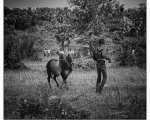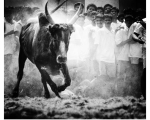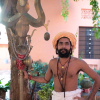Farming in India can be challenging. A farmer has to overcome many hardships to ensure a good harvest. The harvest festival of Pongal celebrated by Tamil people across the world is an expression of gratitude to nature; Jallikattu or ‘bull vaulting’ is a part of this celebration. My family has a coconut farm near Madurai where many people working on the farm participate in Jallikattu or attend the festivities.
The first day of Pongal coincides with Makar Sankranti which marks the first day of the Sun's transit into the Makara (Capricorn) sign, an auspicious day in the Hindu calendar celebrated across India in various communities. Pongal’s significance as a harvest festival includes rituals of cattle veneration and the first rice of the season is fed to bulls. On the third day of Pongal (Mattu Pongal day), bull vaulting events known as Jallikattu are organised across Tamil Nadu. They begin at the local temple and conclude in an arena or open field.
Jallikattu (or Sallikattu) gets its name from salli (coins) and kattu (package), which refers to a bag of coins tied to the bull's horns or around its neck which the participants attempt to retrieve during the festival. Bulls enter the designated competition area through a gate and contestants fling themselves one at a time at the animal in an attempt to wrap their arms around the hump and hold on to it. If they hold on to the bull's neck, horns or tail, they stand disqualified. Rules for winning vary from place to place. In some versions, contestants must either hold the hump for 30 seconds or bring the bull to a stop.
Jallikattu has been recorded as practised in the Tamil region since the classical Sangam period, but the veneration of the bull goes further back in time. The bull has been represented on seals recovered from the Indus Valley Civilization sites and on Mauryan pillars erected by Emperor Ashoka. The bull is also venerated as the semi-divine Nandi, the mount of Shiva. In the past, the culture of bull veneration was shared with many other civilisations in the Middle East and the Mediterranean. The Minoans of Crete had the ritual of bull vaulting, and the bull was an ancient symbol of fertility, virility and strength in Assyria, Sumer, Egypt, Crete, Cyprus, Greece, Babylon, Anatolia, the Levant, Iran, Gaul, Andalusia and the Roman Empire.
Cow vaulting is still practised in the south-west of France. While the bull culture gradually declined in many regions, it has survived in Spain where bulls are pitted against matadors in an arena. The 'Running of the Bulls’ is organised in Spain where a group of bulls are let loose and crowds avoid getting trampled by the charging animals. However, unlike Spanish bullfighting, Jallikattu has a sacred significance and the bulls are not killed. In Tamil Nadu, the bulls are well taken care of and valued as prized possessions by their owners.
I view Jallikattu as a sacred rite of passage, with characteristics of folk craft, ritual, religion, festival and sport. In traditional societies, initiation ceremonies like Jallikattu serve to increase a sense of the sacred, and introduce the participants to the spiritual values of the community. The participant returns to society with a refreshed sense of the sacred and a deeper sense of camaraderie and belonging to his kin group.
A common feature of initiation rites is the ability to endure physical pain or to test one’s courage. Jallikattu provides an opportunity for a man to prove himself in front of the whole village and feel a valued part of his community. Though participants in the actual event of bull vaulting are male, the festival brings together the whole community. On the day of the event, crowds arrive in large numbers at the venue and sit atop bullock carts or on trucks for a better and safer vantage point. Teams are formed and the best bulls are paraded about. The most aggressive bulls are highly prized as studs and sold or rented out for large sums of money. Young women seem to love the festival—dressing up, friends in tow and jasmine in their hair. The men who succeed at it are looked at with admiration. When I asked a young woman in Madurai why they did not take part, she quipped that they did not need Jallikattu given the fact that they go through the pain of childbirth.
Jallikattu helps keep rural communities together and also helps the rural economy. India is going through a massive demographic shift with migration mostly from rural areas to cities. Without cultural events like Jallikattu that keep communities together, the constant migration of people from the interior to cities could ultimately lead to the destruction of local Tamil culture and lifestyle. Jallikattu provides farmers with a source of entertainment, an involvement with the sacred and a sense of cultural belonging. The festival is also important for animal husbandry in Tamil Nadu.
A Bengaluru-based autorickshaw driver told me that while city chaps play with cellphones for entertainment, he returns to his village in Tamil Nadu to battle with the gods once a year.
Integral to the Tamil culture, Jallikattu finds mention in Sangam poetry. An extract from Uruttiran’s poem ‘A Girl describes Jallikattu with the first rains’, translated by A.K. Ramanujan in Poems of Love and War, sums up the atmosphere of the festival in so many words:
With the first rains white clusters of the wild jasmine
backed by fresh thorn
are budding
on nodes once dry
in the cool rain lands.
The bud of the glory lily
looks like a ladle first,
the becomes a fire
when the red petals open
gathering the embers,
and its sways like a drunk.
The bilberry, flowering,
gives nothing but blue gems.
Weaving such blossom
in their wreaths,
cowherds vie with all they have,
enter the stalls
to let loose the bulls,
horns whittled sharp
as the Lord’s own pickaxes.
There, in the middle ground,
where the brides wait,
men gather
again and again
ready to master the bulls,
sounding like rumbling and thunder,
raising dust clouds, and smoke,
offer the right things
to the gods
in watering places,
under the banyan tree
and the ancient mango.

















